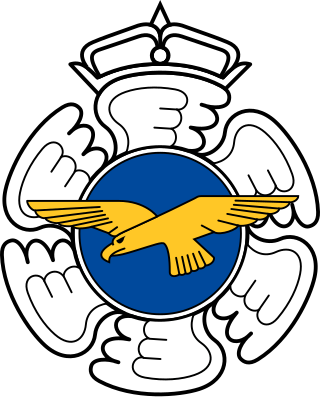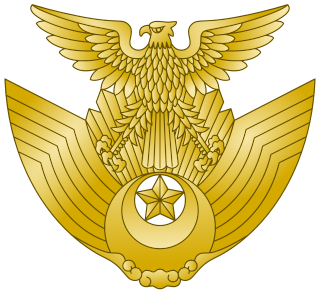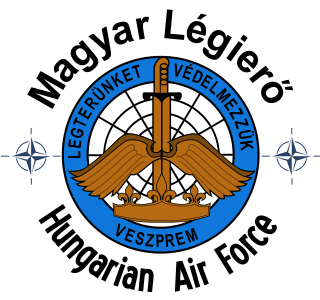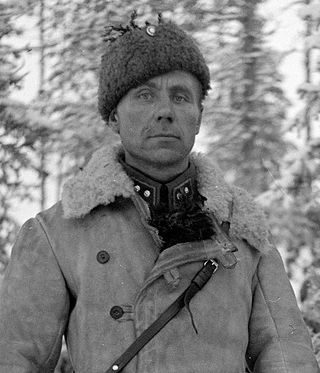Central Air Command may refer to:
- Central Air Command (India), one of five operational commands of the Indian Air Force
- Central Air Command (Sweden), one of three former air commands of the Swedish Air Force
Central Air Command may refer to:

The Lithuanian Armed Forces are the military of Lithuania. The Lithuanian Armed Forces consist of the Lithuanian Land Forces, the Lithuanian Naval Force, the Lithuanian Air Force and the Lithuanian Special Force. In wartime, the Lithuanian State Border Guard Service becomes part of the Lithuanian Armed Forces. A special security department handles VIP protection and communications security.
SAC or Sac may refer to:
A general officer is an officer of high rank in the armies, and in some nations' air forces, space forces, and marines or naval infantry.

A commander-in-chief or supreme commander is the person who exercises supreme command and control over an armed force or a military branch. As a technical term, it refers to military competencies that reside in a country's executive leadership, a head of state, head of government, or other designated government official.
AFC may stand for:

A military band is a group of personnel that performs musical duties for military functions, usually for the armed forces. A typical military band consists mostly of wind and percussion instruments. The conductor of a band commonly bears the title of Bandmaster or Music director. Ottoman military bands are thought to be the oldest variety of military marching bands in the world, dating from the 13th century.

The Finnish Air Force is one of the branches of the Finnish Defence Forces. Its peacetime tasks are airspace surveillance, identification flights, and production of readiness formations for wartime conditions. The Finnish Air Force was founded on 6 March 1918.

The Tenth Air Force is a unit of the U.S. Air Force, specifically a numbered air force of the Air Force Reserve Command (AFRC). 10 AF is headquartered at Naval Air Station Fort Worth Joint Reserve Base/Carswell Field, Texas.

The Japan Air Self-Defense Force, JASDF, also referred to as the Japanese Air Force, is the air and space branch of the Japan Self-Defense Forces, responsible for the defense of Japanese airspace, other air and space operations, cyberwarfare and electronic warfare. The JASDF carries out combat air patrols around Japan, while also maintaining a network of ground and air early-warning radar systems. The branch also has an aerobatic team known as Blue Impulse and has provided air transport in UN peacekeeping missions.

The Vickers Varsity is a retired British twin-engined crew trainer operated by the Royal Air Force from 1951 to 1976.

The Ninth Air Force (Air Forces Central) is a Numbered Air Force of the United States Air Force headquartered at Shaw Air Force Base, South Carolina. It is the Air Force Service Component of United States Central Command (USCENTCOM), a joint Department of Defense combatant command responsible for U.S. security interests in 27 nations that stretch from the Horn of Africa through the Persian Gulf region, into Central Asia.

The Hungarian Air Force, is the air force branch of the Hungarian Defence Forces.

The army rank of captain is a commissioned officer rank historically corresponding to the command of a company of soldiers. The rank is also used by some air forces and marine forces, but usually refers to a more senior officer. Today, a captain is typically either the commander or second-in-command of a company or artillery battery. In the Chinese People's Liberation Army, a captain may also command a company, or be the second-in-command of a battalion.

Mark Anthony Welsh III is Dean of the Bush School of Government and Public Service at Texas A&M University and a retired United States Air Force four-star general. Prior to his current role, he served as Chief of Staff of the United States Air Force and a member of the Joint Chiefs of Staff. He was appointed by President Barack Obama and confirmed by the United States Senate. Prior to that, General Welsh served as Commander of U.S. Air Forces in Europe, as the Associate Director for Military Affairs of the Central Intelligence Agency, and as the Vice Commander of Air Education and Training Command. In earlier portions of his career, he served as a fighter pilot and was a commander at the squadron, group and wing level, in addition to assignments in training, operations, intelligence and acquisitions. He also served as the Commandant of the United States Air Force Academy. He was born in San Antonio, Texas, and entered the Air Force in June 1976 as a graduate of the Air Force Academy.

A squadron in air force, or naval aviation is a unit comprising a number of military aircraft and their aircrews, usually of the same type, typically with 12 to 24 aircraft, sometimes divided into three or four flights, depending on aircraft type and air force. Army aviation does not use air terminology for its command structure. Army squadrons are cavalry squadrons, a different meaning referring to reconnaissance and security units that use land combat vehicles, Army aircraft, or both together. Other land-based squadrons equipped with heavier type aircraft such as long-range bombers, cargo aircraft, or air refueling tankers have around 12 aircraft as a typical authorization, while most land-based fighter equipped units have an authorized number of 18 to 24 aircraft.
Captain is a title, an appellative for the commanding officer of a military unit; the supreme leader of a navy ship, merchant ship, aeroplane, spacecraft, or other vessel; or the commander of a port, fire or police department, election precinct, etc. In militaries, the captain is typically at the level of an officer commanding a company or battalion of infantry, a ship, or a battery of artillery, or another distinct unit. The term also may be used as an informal or honorary title for persons in similar commanding roles.

Chief of Air Force is the most senior appointment in the Swedish Air Force. The position Chief of Air Force was introduced in 1926 and the current form in 2014.
The Defence Staff is the Supreme Commander of the Swedish Armed Forces' staff body and command resource for military strategic command, mission dialogue and reporting to the Swedish government, as well as being responsible for the war organization's capability, availability and combat readiness. The latter with the support of the service branch commanders and the service branch staffs.

The Swedish Armed Forces Headquarters is the highest level of command in the Swedish Armed Forces. Established in 1994, its primary task is to command operations, but is also involved in areas such as military strategy, the overall development of the Swedish Armed Forces, and acting as a channel of contact with government. It's located at Lidingövägen 24 at Gärdet in Stockholm.